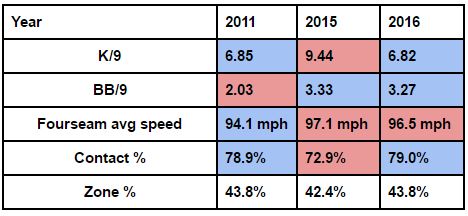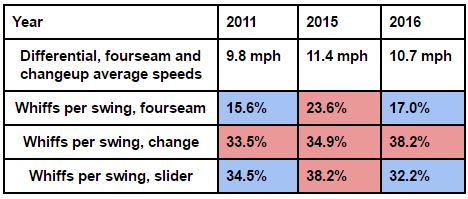Daniel Hudson’s Misses and Swings
The D-backs celebrated the ten year anniversary of becoming World Champions, Brandon Webb attempted a comeback in the Rangers organization, and Katy Perry taught you that you are a firework. Do you remember 2011? That was the season that Daniel Hudson threw more than 80 innings for the organization that traded for him at the 2010 trade deadline, nearly six years ago. He was an innings monster, tossing 222.2 innings in that 2011 season — finishing the year with an ERA (3.49) lower than the mark Zack Greinke currently sports in a D-backs uni (3.62 ERA).
Last year, we saw a completely different Hudson than the one you may barely remember from 2011. As the year progressed, he poured on more and more velocity, appearing to become a better and better reliever version of himself. After showing he could still make hitters look silly with his changeup in his brief 2014 cameo, Hudson blew hitters to pieces in the early going last year, dominating the strike zone in a way that announced his authority but left him with a wan 4.9% K% for that month. When hitters adjusted, he adjusted back, becoming a strikeout machine; by the end of the season, the man we call Huddy had a 24.5% K% that made him look like one of the top relievers in the game.
The velocity is still pretty much there this season — Hudson has averaged a 96.5 mph release speed on his fourseam fastball this year, after averaging 97.1 mph last season and just 94.1 mph as a starter in 2011. Repertoire, too: he’s lived fourseam, change and slider, just like last year. Results? Not so much. Hudson’s unsightly 4.91 ERA is largely the result of a bumpy ride to end June and begin July, but that hasn’t made it easier to look at.
Look what happens, though, when you compare Hudson’s 2011 year as a starter, his relief season in 2015, and his work this year:

Hudson’s been as bad as we can remember, and in terms of strikeouts and walks, it’s like he’s lost the swing-and-miss of his 2015 relief game, but not the pitch-and-miss of his 2015 relief game. Last season, Hudson was no Craig Kimbrel, but he did have a strikeout to walk ratio of nearly 3 to 1; when he was a starter in 2011, that ratio was better than 3 to 1. This season, Hudson is just barely above 2 to 1, and while 25 strikeouts and 12 walks do not make for a large sample size, such numbers tend to stabilize more quickly.
Plate discipline numbers tend to stabilize even more quickly, and they back a similar story. Kind of.

Really, all nine of the whiff rates here are good — but Hudson’s rates in 2015 were excellent, and the rate Huddy is enjoying this season on his change is just plain excellent. The rise in whiff rate on the change is not nearly enough to make up for the drop in whiff rate on the fastball, though, considering he’s thrown 62% fastballs this season. It’s all about the fastball.
But it’s not all about whiff rates. You might think from that 38.2% whiff rate that Hudson’s having a banner season with that change — but nothing could be farther from the truth. When hitters have connected, it’s gone a long way. Stats like slugging percentage help us understand what’s going on with a pitchers’ pitches, but that only tells about what happens when the pitch is the final pitch of an at bat — and we know from Contact% above in particular that Hudson is not getting into as many pitchers’ counts. With a change that drastic, we can expect that Hudson’s secondary pitches have been thrown in favorable counts less often.
So let’s look instead at a more nuanced way to examine pitches’ success and failures: Pitch Values per 100 Pitches, an incredibly nuanced metric that employs linear weights to ensure that nothing like whiff rates are overvalued, compared to other things that make pitches successful. With Pitch Values per 100, a +1 is considered solidly above average as compared to other pitches of that type. Last year, Greinke rode +1.22 fastballs and an average-ish curve (-0.18) to an unusually fantastic season — by combining it with plus plus results on his slider (2.98) and changeup (2.92). Last year, Chase Anderson‘s fastballs had a value of -0.54 runs per 100 pitches, bad but not amazingly bad; what success he had had a lot to do with his 1.32 change.

The truest valuation we can give to Hudson’s pitches look like almost the polar opposite to whiff rates; last year, the only way Hudson’s newfound velocity actually helped him, it seems, was in helping his change to play up (which didn’t make up the difference, really). This season, Hudson’s fastball has been his strength, and the change his undoing, lefties and righties alike.
To help his velocity play up, Hudson has been working with a higher release point as a reliever than he had in the past as a starter; switching up release points may also have been a deliberate adjustment to shift just a bit of the stress of pitching away from his elbow, to his shoulder. It seemed to pay dividends with whiffs last season, but Pitch Values tell us that may have been misleading. Whether Huddy’s step back with control as a reliever is due to his velocity spike or to the release point is anyone’s guess; his secondary pitches haven’t had the same velocity jump, but it’s impossible for me to tell whether he’s missed more often with those because he’s been trying to miss with them.
The swing and miss part of Hudson’s game last year wasn’t helping him the way we thought it was, and in the way we thought it was working last year, it’s not working this year, either. He’s hung around in plate appearances, without blowing anyone away. That’s a fine quality in a starter, but not so much in a pitcher who may now be counted on to close games for the D-backs.
So why not embrace the rest of the transition back to Hudson’s pitching style as a starting pitcher? Most D-backs pitchers seem to throw sinkers too often, and to the wrong hitters — but maybe Hudson joins Shelby Miller as a pitcher who should be throwing one more. Hudson’s line drive rate has been through the roof this season (25.2%), and a sinker could help him return to a rate that looks more like a strength, as in 2011 (19.2%). It wasn’t a featured part of his arsenal (4.7% usage), but it may have helped keep hitters off of his fourseam and his change.
That leads us back to the question of Hudson’s future role for his future team, however, and while the D-backs will insist and rightly believe that wins in 2016 do matter, last week’s underwhelming trade of Brad Ziegler was waving a flag. Is it time to make a “move” with Hudson?
When games “truly” matter again, Hudson is either a reliever, or a starter. If a reliever, something’s gotta change with the change, whether it’s a drop in Hudson’s release point for his fastball and change, or whether it becomes a much less featured part of his arsenal. If a starter, it’s probably time to have Hudson start pitching to contact again as they stretch him out — let him throw his sliders and changeups in the zone more often, to see if they are actually more effective that way. Hudson has already tinkered with his approach against righties this season, and half-measures are probably not the right thing to come next.
The only bad decision, it would seem, would be no decision at all. July is the time to work out Hudson’s future role. If he’s part of the process and completes an extension (perhaps this one) to get there, either choice seems promising, and finally assuming the mantle of closer seems as decent an option as it did last winter. If no deal is struck this month, then the D-backs have no reason at all to stretch him out — he’ll have to wait for that opportunity, if he wants it, in some kind of transition year in 2017.
One Response to Daniel Hudson’s Misses and Swings
Leave a Reply Cancel reply
Recent Posts
@ryanpmorrison
 Best part of Peralta’s 108 mph fliner over the fence, IMHO: that he got that much leverage despite scooping it out… https://t.co/ivBrl76adF, Apr 08
Best part of Peralta’s 108 mph fliner over the fence, IMHO: that he got that much leverage despite scooping it out… https://t.co/ivBrl76adF, Apr 08 RT @OutfieldGrass24: If you're bored of watching Patrick Corbin get dudes out, you can check out my latest for @TheAthleticAZ. https://t.co/k1DymgY7zO, Apr 04
RT @OutfieldGrass24: If you're bored of watching Patrick Corbin get dudes out, you can check out my latest for @TheAthleticAZ. https://t.co/k1DymgY7zO, Apr 04 Of course, they may have overtaken the league lead for outs on the bases just now, also...
But in 2017, Arizona ha… https://t.co/38MBrr2D4b, Apr 04
Of course, they may have overtaken the league lead for outs on the bases just now, also...
But in 2017, Arizona ha… https://t.co/38MBrr2D4b, Apr 04 Prior to the games today, there had only been 5 steals of 3rd this season (and no CS) in the National League. The… https://t.co/gVVL84vPQ5, Apr 04
Prior to the games today, there had only been 5 steals of 3rd this season (and no CS) in the National League. The… https://t.co/gVVL84vPQ5, Apr 04 RT @OutfieldGrass24: Patrick Corbin has a WPA of .318 and it's only the fifth inning., Apr 04
RT @OutfieldGrass24: Patrick Corbin has a WPA of .318 and it's only the fifth inning., Apr 04
Powered by: Web Designers@outfieldgrass24
 This Suns matchup comes at a good time for my hometown Blazers #RipCity https://t.co/fQ45wdfQUk, 4 hours ago
This Suns matchup comes at a good time for my hometown Blazers #RipCity https://t.co/fQ45wdfQUk, 4 hours ago RT @ZHBuchanan: Our @Ken_Rosenthal spoke to Ken Kendrick about trading Paul Goldschmidt.
https://t.co/O5fHRlyBxD, 11 hours ago
RT @ZHBuchanan: Our @Ken_Rosenthal spoke to Ken Kendrick about trading Paul Goldschmidt.
https://t.co/O5fHRlyBxD, 11 hours ago RT @CardsNation247: We have a good show lined up for tonight. Leading off is our friend of the show @buffa82 followed by Jeff Wiser… https://t.co/eltZC0uvyg, 11 hours ago
RT @CardsNation247: We have a good show lined up for tonight. Leading off is our friend of the show @buffa82 followed by Jeff Wiser… https://t.co/eltZC0uvyg, 11 hours ago RT @juanctoribio: To piggyback off the @ZHBuchanan and @OutfieldGrass24 that the #Rays were involved in the Paul Goldschmidt sweepsta… https://t.co/spg9x7X1L5, 11 hours ago
RT @juanctoribio: To piggyback off the @ZHBuchanan and @OutfieldGrass24 that the #Rays were involved in the Paul Goldschmidt sweepsta… https://t.co/spg9x7X1L5, 11 hours ago RT @OJCarrascoTwo: Read this from the world famous, @OutfieldGrass24 https://t.co/cHUie1I5Le, 11 hours ago
RT @OJCarrascoTwo: Read this from the world famous, @OutfieldGrass24 https://t.co/cHUie1I5Le, 11 hours ago
Powered by: Web Designers





Bring on the tuffy…and whats wrong with cody. Your affirmation jinxed him, like i knew it would. Another good call by me.